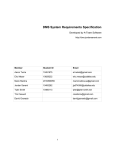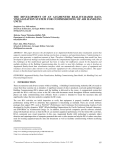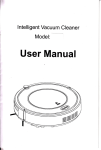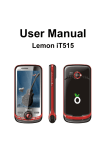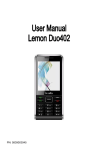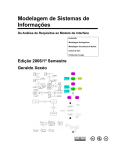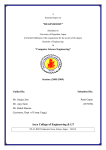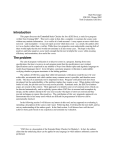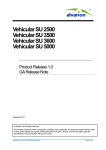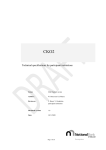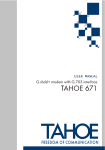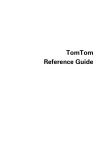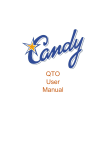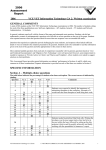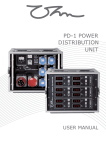Download Synergy Soft Inc. SDMS Requirement Document
Transcript
Synergy Soft Inc. SDMS Requirement Document Version 2.03 The University of Texas at Dallas CS 6361, Section 101 Advanced Requirements Engineering Spring 2009 Revision History Date Version Description Author 03/02/09 1.00 Functional Requirements Phase 1 Akhil Chopra 03/08/09 1.01 Non Functional Requirements Phase 1 Pranay ,Abhishek 03/10/09 1.02 Final Doc Phase 1 Akhil Chopra 04/25/09 2.01 New Requirements Phase 2 Pranay 04/26/09 2.02 Final Doc Phase 2 Akhil Chopra 04/29/09 2.03 Fish Bone Analysis Abhishek Gupta Confidential Synergy Soft Inc Page 2 The University of Texas at Dallas CS 6361, Section 101 Advanced Requirements Engineering Spring 2009 Team ArchitectureUser World: Vishal Sharda, Ankit Sachdeva, Zheng Wang System World: Akhil Chopra, Abhishek Gupta Subject World: Cole Schock, Pranay Patil Developer World: Rajeev Sharma Team Leads: Rajeev Sharma & Akhil Chopra Confidential Synergy Soft Inc Page 3 The University of Texas at Dallas CS 6361, Section 101 Advanced Requirements Engineering Spring 2009 Process Specification Top Level Confidential Synergy Soft Inc Page 4 The University of Texas at Dallas CS 6361, Section 101 Advanced Requirements Engineering Spring 2009 Level -1 Level 1 IDEF0 diagram Abbreviation for Mechanism (Persons) Requirements Engineer-RE Domain Expert-DE Software Developer-SD Team Leader-TL The entire project process was divided into two phases. Confidential Synergy Soft Inc Page 5 The University of Texas at Dallas CS 6361, Section 101 Advanced Requirements Engineering Spring 2009 Phase-1: Confidential Synergy Soft Inc Page 6 The University of Texas at Dallas CS 6361, Section 101 Advanced Requirements Engineering Spring 2009 Phase-2 Domain Constraints Phase 1 Doc & New Requirem ents Doc Final Vision Document Develop Vision Document A23 Develop Documentation Requirements Final SRS Document A22 Develop SRS Describe Product Features & Analysis Models A24 A21 Develop Final Requirement Document Phase-2 Requirements Doc A25 SD,TL,RE,D E Develop SDMS Functional Prototype Phase-1 SDMS Prototype A26 Functional SDMS Prototype SD,TL,RE,D E Confidential Synergy Soft Inc Page 7 The University of Texas at Dallas CS 6361, Section 101 Advanced Requirements Engineering Spring 2009 Table of Contents 1. Introduction 2. Glossary 3. The Domain, Stakeholders, Functional & Non Functional Objectives 3.1 Initial Understanding-Issue Description, Decision and Rationale 4. Functional Requirements 4.1 Initial Understanding-Issue Description, Decision and Rationale 4.2 New Functional Requirements 4.3 Refined Understanding-Modified Requirement and Specifications 5. Non-Functional Requirements 5.1 Issue Description 5.2 Understanding-Decision and Rationale 6. Traceability Confidential Synergy Soft Inc Page 8 The University of Texas at Dallas CS 6361, Section 101 Advanced Requirements Engineering 1. Spring 2009 Introduction This document describes the functional and non functional requirements produced after elicitation and refinement of the initial draft of requirements given by the customer. The document refines the prelim definitions, explores alternatives and provides with rationale and decision behind all the requirements taken into consideration. In addition to the phase-1 work the new requirements given by the customer have been taken into consideration in the section 4.2. It is highly recommended to go through the vision document and the SRS as complimentary documentations to get a better understanding of the overall product. 2 Glossary SDMS-Synergy Distributed Meeting Scheduler Account – Information maintained by the SDMS for each user. User – An individual who has created an Account on the SDMS Initiator- The user who wants to schedule a meeting based on an agenda and a date range. Attendee- A potential meeting attendee who has received an invitation from the initiator. Freeze Date & Time- A date time &set by the initiator before which the potential attendees should give their preference and exclusion date sets and time sessions and also the date & time before which all the negotiations for conflict resolution will be resolved. Active Participants- Potential Meeting Attendees who are invited but whose presence is not absolutely necessary Important Participants- Potential Meeting Attendees who are invited and whose presence is absolutely necessary and without them the meeting cannot take place. Date Range- the potential range of dates in which a meeting may take place Exclusion set- a set of dates on which participants cannot attend the meeting Preference set- a set of dates on which participants would prefer the meeting to take place Strong Conflict- A strong date conflict is when no date can be found within the date range and outside all exclusion sets. Confidential Synergy Soft Inc Page 9 The University of Texas at Dallas CS 6361, Section 101 Advanced Requirements Engineering Spring 2009 Weak Conflict-A weak date conflict is when dates can be found within the date range and outside all exclusion sets, but no date can be found at the intersection of all preference sets. Issues Diagram: Fish Bone Analysis Confidential Synergy Soft Inc Page 10 The University of Texas at Dallas CS 6361, Section 101 Advanced Requirements Engineering Spring 2009 3 The Domain, Stakeholders, Functional & Non Functional Objectives 3.1 Initial Understanding-Issue Description, Decision and Rationale 3.1.1 Issue Description: A meeting initiator will ask all potential meeting attendees for the following information based on their personal agenda. Decision and Rationale: Firstly the term potential attendees does not define the type of role they will play. Initially it was decided that a priority list be created by fixing the level of importance according to the hierarchical status of the users within an organization. This would have created a system based on some weighting mechanism which eventually would have played a role in deciding the quorum of the meetings and conflict resolution. Through further discussions it was thought that it would create un-necessary complexities as organizations will have additional burden of deciding priorities and in an ever changing environment and structure this would defeat the very goal of achieving a quick consensus on scheduling of meetings. Thus we propose only two types of potential attendees as important and active. We leave the task of judging a person as important or active to the meeting initiator and believe that the user will be able to judge this according to the agenda of the meeting. The term asks is not complete as it doesn't mention the mode of asking. Also many modes of communication were thought of like making phone call, text or directly in person. Finally it was decided that the initiator will use the system i.e. SDMS for all sorts of communication related to scheduling of a meeting. Refined Requirement: A meeting initiator shall communicate with the potential meeting attendees using SDMS before the freeze date. The potential attendees will be marked either as active or as important. 3.1.2 Issue Description: A meeting date shall be defined perhaps by a pair (calendar date, time period) Decision and Rationale The term perhaps is ambiguous and should be omitted. Refined Requirement: The meeting initiator shall select time period during which the meeting will occur. The period should be defined by a start date and time and an end date and time both in the following format: yyyy/mm/dd HH:MM AM/PM Confidential Synergy Soft Inc Page 11 The University of Texas at Dallas CS 6361, Section 101 Advanced Requirements Engineering 3.1.3 Spring 2009 Issue Description: The exclusion and preference sets should be contained in some time interval prescribed by the meeting initiator (hereafter referred to as date range) Decision and Rationale This is incomplete as it does not specify the upper bounds for the date range. Refined Requirement: The initiator should select set of dates in the range of within 1 year from the current date. The potential attendees should also select any number of preference and exclusion sets within this range. 3.1.4 Issue Description The initiator could also ask, in a friendly manner, active participants to provide any special equipment requirements on the meeting location (e.g., overhead projector, workstation, network connection, telephone). Decision and Rationale This requirement is ambiguous and redundant as the phrase ‗friendly manner‘ is not clear and the mode of asking has already been mentioned previously in Issue-1. As proposed in Issue-1 only two types of participants are there important and active. Now both can be asked but we decided to go only with asking the important participants as their needs are important for the meeting to take place. Also the phrase ‗could also ask‘ is not concrete. Refined Requirement: The initiator should ask all important participants to provide a list of equipment needed at the meeting location. 3.1.5 Issue Description She may also ask important participants to state preferences about the meeting location. Decision and Rationale This requirement is incomplete as it does not state the preferences of the active participants. The important participants can be asked about their preferred locations but we thought it would create un-necessary confusion and would act as an impediment for reaching the main consensus on the schedule of meeting. Thus it was decided to drop this requirement. But this can be added if demanded by the customer if the location has more priority than successful scheduling of the meeting irrespective of the location. Refined Requirement (Optional): The initiator should ask important participants to mention their preferred meeting location through SDMS system. Confidential Synergy Soft Inc Page 12 The University of Texas at Dallas CS 6361, Section 101 Advanced Requirements Engineering 3.1.6 Spring 2009 Issue Description The proposed meeting date should belong to the stated date range and to none of the exclusion sets; furthermore it should ideally belong to as many preference sets as possible. Decision and Rationale This requirement is incomplete as it does not answer the following questions: What happens if the meeting does not belong to any of the preference sets? Is it cancelled or rescheduled or are the participants asked to revise their preference sets? If asked to revise how many times this negotiation should take place? What is meant by ‗as many as’? Does it mean that we are considering all the participants equally? What if none of the important participants have their preference dates available in the ‗as many‘ preference sets and only active participants are available? Thus we define concretely the important participants and propose two alternatives which will be followed if a date is found in the date range and outside the exclusion sets of the important participants in the following order i) Select a date which falls in most preference sets of the important participants .This is from the attendee‘s point of view where convenience of maximum people is taken into consideration. If not possible then ii) Select a date which is earliest which is the earliest in the range. This means picking a date earliest in the range.(From organization‘s point of view which wants the meetings to be held as early as possible) Refined Requirement: The proposed meeting date should belong to the stated date range and to none of the exclusion sets of the important participants if such a date cannot be found these alternatives shall be applied in the following order: i. Select the earliest date which falls in most preference sets of the important participants. If not possible then ii. 3.1.7 Select the earliest date that does not fall in any exclusion sets within the date range. Issue Description The proposal should be made as early as possible. Decision and Rationale This requirement is incomplete and ambiguous as it does not mention ‗how‘ early? There should be a freeze time before which the proposal for the meeting can be made. This is because it‘s not feasible to schedule meetings for which the starting time is less than 3 hours from the current time. Confidential Synergy Soft Inc Page 13 The University of Texas at Dallas CS 6361, Section 101 Advanced Requirements Engineering Spring 2009 Refined Requirement: The proposal should be made before the freeze date & time 3.1.8 Issue Description A date conflict occurs when no such date can be found. A conflict is strong when no date can be found within the date range and outside all exclusion sets; it is weak when dates can be found within the date range and outside all exclusion sets, but no date can be found at the intersection of all preference sets. Decision and Rationale This requirement is about the conflicts where a conflict occurs when no proposed date is found. The word ‗no such date‘ is incomplete as it doesn‘t define the type of date. Further the present requirement categorizes a conflict as weak and strong. The issue of weak conflict is addressed in section 3.1.6 and for a strong conflict i.e. when no date can be found within the date range and outside all exclusion set, the only way to resolve this is negotiation. Refined Requirement: A strong date conflict is when no date can be found within the date range and outside all exclusion sets; a weak date conflict is when dates can be found within the date range and outside all exclusion sets, but no date can be found at the intersection of all preference sets. The strong conflict shall be resolved through negotiations which shall follow a set of alternatives in an iterative manner till a date is found. 3.1.9 Issue Description Conflicts can be resolved in several ways, including: the initiator extends the date range; and some participants remove some dates from their exclusion set. some participants withdraw from the meeting; some participants add some new dates to their preference set. Decision and Rationale This requirement lists ways to resolve a strong conflict. It‘s ambiguous and incomplete with words like ‗some‘ and thus is rephrased. The alternative of withdrawal from the meeting is dropped. Refined Requirement: Strong Conflicts shall be resolved by the following steps. The initiator extends the date range OR Important participants remove some dates from their exclusion set. OR Important participants add new dates to their preference set. Confidential Synergy Soft Inc Page 14 The University of Texas at Dallas CS 6361, Section 101 Advanced Requirements Engineering Spring 2009 These steps shall be iterative till a date is found. 3.1.10 Issue Description Each conflict resolution should be done as quickly as possible and with no more interactions than is really needed. Decision and Rationale This requirement is ambiguous due to the phrase ‗as quickly as‘ and ‗really‘. The weak conflict will be resolved as mentioned in 3.1.6 and strong conflicts will be resolved as defined by section 3.1.9 Refined Requirement: The negotiations for resolving strong conflict shall be done before the freeze time. There shall be no restrictions on the number of negotiations till a date is found before the freeze time. 3.1.11 Issue Description A meeting room must be available at the selected meeting date. It should meet the equipment requirements; furthermore it should ideally belong to one of the locations preferred by as many important participants as possible. Decision and Rationale This requirement is incomplete as it does not mention what happens if the meeting room is not available on the selected meeting date. Refined Requirement: A meeting room shall be selected by the initiator using SDMS based on the cumulative list of equipment requested for the meeting. 3.1.12 Issue Description The number of negotiations should be kept minimal, but a new round of negotiation may be required when no such room can be found. Decision and Rationale This requirement is incomplete as it does not mention what is meant by ‗negotiations‘ and how the negotiations will be carried out. There were a couple of options suggested for one being that the meeting initiator shall negotiate with the other meeting initiator with whom the room is currently reserved. Such a negotiation shall be completed before the freeze time. The negotiation will be conducted by means of posting comments in the SDMS, which is visible only to the meeting initiators. If the negotiation succeeds then the meeting that is scheduled will be relocated or rescheduled to make way for the proposed meeting. If the negotiation fails Confidential Synergy Soft Inc Page 15 The University of Texas at Dallas CS 6361, Section 101 Advanced Requirements Engineering Spring 2009 then the meeting will be rescheduled. These negotiations will be conducted only if an alternate room cannot be found on the required date and time. However it was later felt that this will add complexity to the system and will add confusion as there is no such way to determine how successful these negotiations can be at first place. Thus it was decided not to have these negotiations. Instead if the location for the proposed date cannot be found then the system will wait till the freeze time so as to check if that location is available in case some other meetings were cancelled and is free for the proposed date and time. If the location still cannot be determined then it will be regarded as a case of strong conflict and will be resolved as mentioned in 3.1.9. Refined Requirement: If the location for the proposed date cannot be found then the system will wait till the freeze time so as to check if that location is available in case some other meetings were cancelled and is free for the proposed date and time. If the location still cannot be determined then it will be regarded as a case of strong conflict and will be resolved as mentioned in 3.1.9. 3.1.13 Issue Description It is absolutely necessary, however, to allow each meeting to take place in a virtual place, e.g., through teleconferencing using laptop computers. This flexibility is considered crucial in future. Decision and Rationale The requirement is ambiguous because it takes teleconferencing as both ―absolutely necessary‖ and ―crucial in future.‖ This makes it unclear whether this is an immediate requirement or a feature expected in future releases. We decided that since virtual support is important as it plays an important role in collaborations irrespective of the locations, the support of video/text chat, teleconferencing will be given. This support will further help in conflict resolution as location constraints can be avoided. This requirement needs to be rephrased to make it clearer. Refined Requirement: The SDMS shall support text/video chat, and teleconferencing to allow each meeting to take place through a virtual place. 3.1.14 Issue Description The number of negotiations should be kept minimal, but a new round of negotiation may be required when no such room can be found. Decision and Rationale Confidential Synergy Soft Inc Page 16 The University of Texas at Dallas CS 6361, Section 101 Advanced Requirements Engineering Spring 2009 This requirement is redundant and is addressed in section 3.1.12. 3.1.15 Issue Description The meeting initiator can be one of the participants or some representative (e.g., a secretary). Decision and Rationale This requirement is unclear as it doesn‘t define who can be a initiator. A few options were considered while deciding the initiator like a secretary or a manager. But it was felt that defining the initiator within the SDMS system will limit its application. Thus to maintain the scope of the system it was decided that anybody can be a initiator. This requirement also needs re-phrasing. Refined Requirement: The SDMS system shall be used by anybody who is registered in the system to initiate the meeting regardless of whether they are a potential attendee or not. 4. Functional Requirements 4.1 Initial Understanding-Issue Description, Decision and Rationale 4.1.1 Issue Description: The purpose of SDMS is to support the organization of meetings – that is, to determine, for each meeting request, a meeting date and location so that most of the intended participants will effectively participate. Decision and Rationale This requirement is forms the part of vision and is addressed in section 1. 4.1.2 Issue Description: SDMS shall assist users in the following activities: Monitor meetings, especially when they are held in a distributed manner; Plan meetings under the constraints expressed by participants. Decision and Rationale This requirement is incomplete and ambiguous since the ways of monitoring ways are not defined. Through discussions it was observed that the only way the meeting scheduler can help in monitoring meeting was to save the chat contents for those attendees joining the meeting through chat. Also this requirement was not felt immediate to implement for the system. After further discussions with the user and also the legal authorities it was learnt that it was not advisable to log chat contents either and it was in the best of interest not to have any Confidential Synergy Soft Inc Page 17 The University of Texas at Dallas CS 6361, Section 101 Advanced Requirements Engineering Spring 2009 legal complications and thus dropping this requirement was recommended. Further clarification regarding the requirement can be referred to the section 5. NFR-1. 4.1.3 Issue Description: Re-plan a meeting to support the changing user constraints, for instance: to modify the exclusion set, preference set and/or Preferred location before a meeting date/location is proposed; and to take some external constraints into account after a date and location have been proposed e.g., due to the need to accommodate a more important meeting. - here, the original meeting date or location may then need to be changed; sometimes the meeting may even be cancelled. In all cases some bound on re-planning should be set up. Decision and Rationale This requirement is redundant and all the issues are addressed in sections 3.1.8 to 3.1.12 4.1.4 Issue Description: Support conflict resolution according to resolution policies stated by the client; Manage all the interactions among participants required during the organization of the meeting, for instance: to support the negotiation and conflict resolution processes; to make participants aware of what's going on during the planning process; to keep participants informed about schedules and their changes. Decision and Rationale This requirement again talks about negotiations and conflict resolution which have been addressed in sections 3.1.8 to 3.1.12. The user requirement of updating about any changes is refined as follows. Refined Requirement The system shall inform all the users about any changes in the schedules, location through periodic updates and reminders. 4.2 New Functional Requirments 4.2.1 Issue Description: Make a choice : Accept, accept as tentative, or decline each meeting request that you receive, especially if it is an update to a meeting request that you previously accepted. By Confidential Synergy Soft Inc Page 18 The University of Texas at Dallas CS 6361, Section 101 Advanced Requirements Engineering Spring 2009 making a choice, you keep the meeting organizer apprised of your decision and you prevent the meetings that you want to attend from being accidentally deleted. If you need to attend a meeting but can't at the time it is scheduled, you can propose a new time for the meeting. Try not to delete a meeting request outright because this is one way that meetings get "lost." Decision and Rationale The current versions of the SDMS has implemented accepting the meeting feature, however declining the meeting and accept as tentative feature is yet to be incorporated. These two features would be incorporated in the future versions of the SDMS. The deleting a meeting feature would be so implemented that even if a meeting is deleted from the list of meeting it would be visible in the declined section instead of disappearing from the participant‘s home page. To actually delete a meeting from the system the participant would have to delete a meeting from the declined meeting section. Currently the SDMS software does the job of coming up with a date such that it fits into the best possible schedule for all the participants of the meeting and in the opinion of the team it is a better way to go about scheduling the meeting by leaving the decision in the hands of the scheduling software to come up with a single date which is acceptable for all, rather than the participants explicitly proposing a new time for the meeting in case they find it not possible to attend the meeting. Instead the participants have their exclusion sets which are visible to the initiator. Proposing a new meeting time has not been considered in the present version of the SDMS and it has been decided to implement it in later versions. 4.2.2 Issue Description: Send updates: After modifying one of your own meeting requests, remember to click Send Update to send the updated request to all recipients. Decision and Rationale The current version of SDMS has not incorporated the feature but the feature can be implemented in the later versions as this is a new functionality and the current design requires modifications to implement the feature. In the future versions of the SDMS a feature for editing meeting request would be implemented ,which will allow the initiator to edit the meeting requests and send the updated version of the meeting to participants of the meeting. 4.2.3 Issue Description: Cancel a single meeting If you need to cancel a meeting, it is considerate to notify the people you invited. Delete the meeting from your calendar, click Send cancellation and delete meeting, and then send the cancellation to everyone you invited. Decision and Rationale The SDMS plans to incorporate the feature in later versions by simply sending out a new message from the initiator by which the participants would be informed about which meeting has been cancelled. The participants can mark the meeting cancelled in their list of meeting and can delete the meeting form their home page if they want to. 4.2.4 Issue Description: Cancel recurring meeting If you, as the meeting organizer, are ending a recurring series of meetings, open the meeting on your calendar, set a new end date, and then send an update. Confidential Synergy Soft Inc Page 19 The University of Texas at Dallas CS 6361, Section 101 Advanced Requirements Engineering Spring 2009 This keeps the past meetings on everyone‘s calendars, but future occurrences after the end date are removed.. Decision and Rationale The recurring meeting functionality has not been implemented in the SDMS as of now but would be implemented in future versions. The update meeting functionality is also not been incorporated in the present version as mentioned in 4.2.2. 4.2.5 Issue Description: Change meeting organizers If a recurring meeting is changing to a new organizer, there is not a way to reassign the ownership of the meeting. The original organizer should send an update with a new end date — the past meetings remain on everyone‘s calendars, but future occurrences after the end date are removed. The new meeting organizer should send a new meeting request for meetings in the future. Decision and Rationale There is a page which shows list of meetings wherein a new owner who would be the new initiator of the meeting can be selected from the initiator‘s home page. The feature is only implemented only for single occurrence of the meeting and has yet to be implemented for recurring meetings and as mentioned in 4.2.4 the feature would be implemented. 4.2.6 Issue Description: Keep meetings from vanishing If you run Outlook on two computers and accept a meeting while using one of them; don't delete the meeting request from the Inbox on the other computer. If the request is still there, accept it again. Deleting a request on one computer after accepting it on another computer can cause the meeting to disappear from your calendar. Decision and Rationale This feature is a new requirement which is significantly differently from the existing design of the SDMS, making it difficult to add the functionality in this version. Therefore this feature would be implemented in the next version. 4.2.7 Issue Description: Process meeting requests and updates from the Inbox Always accept or decline a meeting request from your Inbox. Yes, Outlook allows you to accept or decline a meeting from its time slot on your calendar, but that can leave the meeting request in your Inbox. Leaving the meeting request in your Inbox might confuse you later and definitely leaves any delegates (delegate: Someone granted permission to open another person's folders, create items, and respond to requests for that person. The person granting delegate permission determines the folders the delegate can access and the changes the delegate can make. Decision and Rationale This feature is not being implemented as it differs radically from the existing system and it shall be treated as an additional software component which the client wants to implement. The inbox feature was not mentioned at all in the initial requirements documentation. Confidential Synergy Soft Inc Page 20 The University of Texas at Dallas CS 6361, Section 101 Advanced Requirements Engineering 4.2.8 Spring 2009 Issue Description: Keep your meeting notes separate As a meeting attendee; avoid adding your own private notes to the body of a meeting request in your calendar. If the organizer updates the meeting, your notes are lost. Decision and Rationale This feature is not being implemented as it radically from the existing system and it shall be treated as an additional software component which the client wants to implement. To add the notes feature the initial design requirement wherein only initiator can send notes would have to be scrapped which would lead to major changes in the software. The team has therefore decided not implement this feature in the SDMS. 4.2.9 Issue Description: Don't move meeting requests Don't move a meeting request from your Inbox to a different folder before you accept or decline the request or before the meeting appears in your calendar. Soon after a meeting request arrives in your Inbox, a piece of Outlook code — nicknamed the "sniffer" — automatically adds the meeting to your calendar and marks it as tentative. This is a fail-safe to keep you from missing the meeting in case you don't see the request in your Inbox. However, the sniffer doesn't reply to the meeting organizer. You still need to do that by accepting, accepting as tentative, or declining the request. If you or a rule that you create moves an incoming meeting request from your Inbox before the sniffer can process the request, the meeting never appears in your calendar, and you might miss the meeting. Decision and Rationale This feature is not being implemented as it differs radically from the existing system and it shall be treated as an additional software component which the client wants to implement. The inbox feature was not mentioned at all in the initial requirements documentation. 4.2.10 Issue Description: May Adrienne come, too? If you receive an invitation for a meeting and believe someone else should also attend it, instead of forwarding the meeting request to that person, ask the meeting organizer to add that person to the attendee list, and then to send everyone an updated meeting request. This avoids surprising the organizer with an unexpected attendee and helps prevent lost meeting requests Decision and Rationale In the current version the feature is not implemented in the system, in the future versions this feature can be implemented by letting the initiator edit the meeting and add the new participant to the mailing list. 4.2.11 Issue Description: There is always room for one more If you are the meeting organizer and you want to invite another person after sending the original meeting request, add the person to the attendee list (the To line) of the original meeting series or occurrence, and then send an update to all attendees. Confidential Synergy Soft Inc Page 21 The University of Texas at Dallas CS 6361, Section 101 Advanced Requirements Engineering Spring 2009 Decision and Rationale In the current version the feature is not implemented in the system, in the future versions this feature can be implemented by letting the initiator edit the meeting and add the new participant to the mailing list. 4.2.12 Issue Description: Convert an appointment to a meeting request If you want to create a meeting from an appointment on your calendar, open the appointment, click Invite Attendees, and then select the people you want to invite. This converts the appointment to a meeting request. Decision and Rationale The requirement needs the software to be redesigned to add the new functionality which is presently out of the scope of the software being developed. Hence this requirement cannot be fulfilled. 4.2.13 Issue Description: Remove it right If you receive a meeting cancellation, click Remove from Calendar to remove the meeting from your calendar. Deleting the cancellation from your Inbox won't remove the meeting from your calendar. Decision and Rationale The requirement needs the software to be redesigned to add the new functionality which is presently out of the scope of the software being developed. Hence this requirement cannot be fulfilled. 4.2.14 Issue Description: Try not to change an existing attendee list suppose the attendee list in one of your meeting requests contains two instances of a person's name. If you delete one of the names, and then send a meeting update to the "Removed or Added Attendees," the person receives a cancellation. Similarly, if you send the meeting update to "All Attendees," the person receives both a cancellation and an update. Decision and Rationale At the present moment this feature is not being considered. In future implementations the SDMS would be designed such that it will not allow two instances of an attendee to be entered into the list of potential participant who are going to be invited to the meeting. 4.2.15 Issue Description: Be careful with DLs Try to avoid sending meeting requests to distribution lists (DLs), particularly ones that you are a member of. If you need to invite all the members of a distribution list, expand the list in the to line before sending the request. If you need to add or remove attendees from a meeting request that you already sent to an unexpanded distribution list, don't expand the list and start adding or deleting names. Instead, cancel the meeting and create a new one. Confidential Synergy Soft Inc Page 22 The University of Texas at Dallas CS 6361, Section 101 Advanced Requirements Engineering Spring 2009 Decision and Rationale This is more of a guideline to the user rather than a new requirement; this need not be considered in the list of requirements. 4.2.16 Issue Description: Don't auto-accept requests If you have granted one or more persons delegate access to your calendar or if you have delegate access to someone else's calendar, turn off automatic acceptance of meeting requests. By turning off automatic acceptance you avoid problems with delegate workflow. Decision and Rationale Auto accept feature has not been considered in the SDMS as it is assumed that participant has to read each and every meeting request and then decide upon that if its fits the schedule of the participant and in case if there is a change in the schedule later after accepting the meeting request using the auto accept mode then it may create confusion or clash of meetings which is undesirable. 4.2.17 Issue Description: Avoid calendar clutter To make people aware of your schedule, or to let them know when you plan to be away from the office, don't send a meeting request or forward appointments that block out portions of your schedule on their calendars. Instead, share your calendar with them. If you don't want to share your calendar, you can still use a meeting request to let people know when you will be away from the office. Before you send the meeting request, set Show time as to Free so that it doesn't block out the time that you are away as Busy or Out of Office on the other people's calendars. So what if someone sends a meeting request or appointment that blocks out portions of your calendar? If you accept the item (item: An item is the basic element that holds information in Outlook (similar to a file in other programs). Items include e-mail messages, appointments, contacts, tasks, journal entries, notes, posted items, and documents). Set Show time as in the item to Free. Decision and Rationale The requirement needs the software to be redesigned to add the new functionality which is presently out of the scope of the software being developed. Hence this requirement cannot be fulfilled. 4.3 Refined Understanding-Modified Requirement and Specifications User Management: FR-1 A meeting initiator shall communicate with the potential meeting attendees using SDMS before the freeze date. The potential attendees will be marked either as active or as important. FR-2 The SDMS system shall be used by anybody who is registered in the system to initiate Confidential Synergy Soft Inc Page 23 The University of Texas at Dallas CS 6361, Section 101 Advanced Requirements Engineering Spring 2009 the meeting regardless of whether they are a potential attendee or not. Meeting Planning: FR-3 The proposal should be made before the freeze time. FR-4 The meeting initiator shall select time period during which the meeting will occur. The period should be defined by a start date and time and an end date and duration. FR-5 The initiator should select set of dates in the range of within 1 year from the current date. The potential attendees should also select any number of preference and exclusion sets within this range. FR-6 The proposed meeting date should belong to the stated date range and to none of the exclusion sets of the important participants if such a date cannot be found these alternatives shall be applied in the following order: i. Select the earliest date which falls in most preference sets of the important participants. If not possible then ii. Select the earliest date that does not fall in any exclusion sets within the date range. Based on the suggested date and session of the meeting the initiator will specify the exact time to the participants. FR-7 The system shall inform all the users about any changes in the schedules, location through periodic updates and reminders. FR-8 The SDMS will support text/video chat, and teleconferencing to allow each meeting to take place through a virtual place. Conflict Resolution: FR-9 A strong date conflict is when no date can be found within the date range and outside all exclusion sets; a weak date conflict is when dates can be found within the date range and outside all exclusion sets, but no date can be found at the intersection of all preference sets. The strong conflict shall be resolved through negotiations which shall follow a set of alternatives in an iterative manner till a date is found. FR-10 Strong Conflicts shall be resolved by the following steps. The initiator extends the date range OR Important participants remove some dates from their exclusion set. OR Important participants add new dates to their preference set. These steps shall be iterative till a date is found. Confidential Synergy Soft Inc Page 24 The University of Texas at Dallas CS 6361, Section 101 Advanced Requirements Engineering Spring 2009 FR-11 The negotiations for resolving strong conflict shall be done before the freeze time. There shall be no restrictions on the number of negotiations till a date is found before the freeze time. Location Planning: FR-12 The initiator shall ask all important participants to provide a list of equipment needed at the meeting location. FR-13 A meeting room shall be selected by the initiator using SDMS based on the cumulative list of equipment requested for the meeting. FR-14 If the location for the proposed date cannot be found then the system shall wait till the freeze time so as to check if that location is available in case some other meetings were cancelled and is free for the proposed date and time. If the location still cannot be determined then it will be regarded as a case of strong conflict and will be resolved as mentioned in FR10. Additional requirements implemented in current version: FR-15 The SDMS will have user accounts of each user to login as a meeting initiator or as participant. FR-16 The meeting organizer can be changed by the initiator of the meeting. Additional requirements considered for implementation in later versions: FR-17 The decline a meeting and mark meeting as tentative shall be included in the next release of the SDMS. FR-18 The send updates shall be included in the next version of the SDMS. FR-19 The cancel a meeting and cancel a recurring shall be included in the next version of the SDMS. FR-20 If there is an invitation for a meeting and believes someone else should also attend it This feature can be implemented in the later versions depending on the priority of requirements listed from the client. FR-21 There is room for one more that is adding a new participant to a meeting for which an invite has been sent shall be implemented along with FR-20 in the next version depending on client‘s priorities of requirements. FR-22 If there are two instances of a person‘s name- At the present moment this feature is not being considered. In future implementations the SDMS would be designed such that it will not allow two instances of an attendee to be entered into the list of potential participant who are going to be invited to the meeting. FR-23 The SDMS will have user accounts of each user to login as a meeting initiator or as participant. Additional requirements not considered: There are additional requirements in the new requirements document which will not be implemented as the design team feels that the software would have to be changed Confidential Synergy Soft Inc Page 25 The University of Texas at Dallas CS 6361, Section 101 Advanced Requirements Engineering Spring 2009 significantly and some of the functionality is different from what the current SDMS is designed to do. The design team also feels that there are requirements which mentioned in the new requirements document , which are conflicting in nature and there are requirements mentioned which may not be requirements at all in the first place The list of such requirements is mentioned below4.2.6, 4.2.7, 4.2.8,,4.2.9, 4.2.12, 4.2.13, 4.2.15(not a requirement but an instruction to the user of the software),,4.2.16(conflicting requirement),4.2.17. Confidential Synergy Soft Inc Page 26 The University of Texas at Dallas CS 6361, Section 101 Advanced Requirements Engineering Spring 2009 5. Non-Functional Requirements 5.1 Issue Description UNFR-1: A meeting should be accurately monitored, especially when it is held in a virtual place. Here, nomadicity will then be important to consider. UNFR-2: The Requirement states that re planning of a meeting should be done as dynamically and with as much flexibility as possible. UNFR-3: The Requirement states that ―the amount of interaction among the participants should be kept minimal‖. UNFR-4:The intended system should considerably reduce the amount of overhead usually incurred in organizing meetings where potential attendees are distributed over many different places and communicate with each other, for example. via the internet. UNFR-5: The requirement states that ―The system should reflect as closely as possible, the way, meetings are typically managed‖ UNFR-6:The requirement states that ―The meeting location should be as convenient as possible, and available as early as possible, to all‖ UNFR-7:The requirement states that ―The system should accommodate as much decentralized requests as the possible ,any authorized users should be able to request a meeting independently of her whereabouts ‖ UNFR-8:The requirement states that ―Physical Constraints should not be broken....eg...a person may be at two different places at the same time ; a meeting room may not be allocated to more than one meeting at the same time . UNFR-9:The requirement states that ―The system should provide an appropriate level of performance →elapsed time between the submission of a meeting request & determination of the corresponding date/location should be minimal; OR → a lower bound should be fixed between time at which the meeting date is determined and time at which meeting is actually taking place. UNFR-10:The requirement states that ―The system shall be usable by non-experts‖ UNFR-11:The requirement states that ―The system should be customizable to professional as well as private meetings‖. UNFR-12: The requirement states that ―The system should be flexible enough to accommodate evolving data e.g. sets of concerned participants may be varying, the address at which a participant can be reached may be varying. 5.2 Understanding-, Decision and Rationale NFR-1: A meeting should be accurately monitored, especially when it is held in a virtual place. Here, nomadicity will then be important to consider. Issue Description: Accurately monitored & nomadicity are ambiguous terms ,monitoring meeting accurately could mean whether everything discussed in the meeting is correct or whether everything discussed in Confidential Synergy Soft Inc Page 27 The University of Texas at Dallas CS 6361, Section 101 Advanced Requirements Engineering Spring 2009 the meeting was recorded correctly, similarly nomadicity could mean participants moving from one location to another. The term ―monitoring‖ is also ambiguous as monitoring can be interpreted in different context by different participants It can be thought of as monitoring changes in the user schedule or monitoring the meeting. Options: 1) Add a new requirement concerning the monitoring module. 2) Save ―Chat/Meeting‖ either as a voice or a text log file. 3) The initiator will appoint one of the confirmed participants to record the minutes of meeting and upload the minutes of the meeting on the SDMS for all other participants. Solution(Understanding): Consider that the requirement is stating that all meetings must be accurately monitored and attempt to provide features accordingly. This is the best case scenario but practically very expensive to implement in the SDMS software. The most practical solution appears to be option 3 wherein the initiator appoints a confirmed participant to record minutes of the meeting, it is easy to implement as well as inexpensive. NFR-2: The Requirement states that replanning of a meeting should be done as dynamically and with as much flexibility as possible. Issue Description: ―Dynamically‖ and ―'with as much flexibility as possible‖ are very subjective, and do not clearly state how the system should be dynamic and flexible. Options: Allow the important participants to choose their location preferred and change their date and time preference sets along with the equipments , any number of times Allow the initiator to choose their location and change their date and time preference sets along with the equipments. Allow the Initiator to choose their location, but allow the important participants to change their date-time preference sets limited number of times. Solution(Understanding): Allowing the important participants to choose their location and date preference as many time as they want will give maximum flexibility to participants but will lead to a situation where the SDMS will not be able to find an appropriate location and date pair and the meeting may then go into a infinite loop of rescheduling. To avoid this the system proposed by our company would allow the initiator to select the location initially while sending out the meeting request. The participants are allowed to change their date- time preference and participation status till the ‗Freeze time‖ after which they cannot make any changes to the preference sets or the exclusion set. This does reduce the flexibility but increases the chances of conducting the meeting on the given location and date. Confidential Synergy Soft Inc Page 28 The University of Texas at Dallas CS 6361, Section 101 Advanced Requirements Engineering Spring 2009 NFR-3: The Requirement states that ―the amount of interaction among the participants should be kept minimal‖. Issue Description: The term ―minimal‖ is relative and hence is ambiguous. The amount of interaction among the participants should be kept minimal , as to in what context whether during a meeting or not. Options: 1) The SDMS should have a restriction on the number of messages to be sent by the important participants while negotiating. 2) Allow the meeting initiator to decide how many messages can be sent across the system. Solution(Understanding): Allow the meeting initiator to decide about the amount of interactions that the users can have through the system, and let the system ask him to finalize the meeting details. This will reduce the flexibility offered to participants in terms of attending the meeting and hence reduce probability of participants attending the meeting. To avoid the scenario the system lets the important participant interact with the initiator as many times they need to ,but before the freeze time. NFR-4: The intended system should considerably reduce the amount of overhead usually incurred in organizing meetings where potential attendees are distributed over many different places and communicate with each other, for example. via the internet. Issue Description: Here, 'reduce the amount of overhead' is redundant because it could be interpreted as minimal amount of interactions .The term is also ambiguous as the overhead incurred could be in terms of resources required in order to hold a meeting . Solution(Understanding): The SDMS shall be the only communication channel to be used by the participants, and no additional software requirements should be needed to access the system. This will lead to considerable reduction in overhead costs in organizing meetings because all the activities regarding the meeting would be taken care by a single software. Since the SDMS is web based only requirement for communication would be availability of a PC and internet for communication. NFR-5: The requirement states that ―The system should reflect as closely as possible, the way, meetings are typically managed‖ Confidential Synergy Soft Inc Page 29 The University of Texas at Dallas CS 6361, Section 101 Advanced Requirements Engineering Spring 2009 Issue Description : The phrase ― typically managed‖ and ―as closely as possible‖ are ambiguous and do not state the requirement clearly. This is a redundant requirement, since it resembles the first non functional requirement ,NFR-1. Options: The System should have a provision of recording meetings using recording equipments like a video camera or a text log file in case of virtual meetings. The Initiator should ,himself record the minutes of meeting manually while the meeting is conducted. The Initiator should ask two confirmed participants to record the minutes of meeting manually . Solution(Understanding): The best solution for this requirement is to let the initiator assign two confirmed participants while sending out the agenda,after freeze time to record minutes of meeting manually while the meeting is conducted and later on the person should upload the minutes on the scheduler system . NFR- 6: The requirement states that ―The meeting location should be as convenient as possible, and available as early as possible, to all‖ Issue Description : The phrase ―as convenient as possible ‖ and ―as early as possible‖ are ambiguous and do not state the requirement clearly. The statement says that, it wants the meeting location to be easier to reach and available with the first date in range of the meeting. Options: Let the Initiator decide the location on his own, and not give any authority to the partipants Let the important participants gives their location preferences and , then let the initiator decide the location based on the preferences of the important participants. Solution(Understanding): The system is designed in such a way, that it gives the option to the important participants,to select their preferred date and time preference sets. The Initiator can , then decide the location based on the availability on the preferred date , which is selected by the SDMS. NFR- 7: The requirement states that ―The system should accommodate as much decentralized requests as the possible ,any authorized users should be able to request a meeting independently of her whereabouts ‖ Confidential Synergy Soft Inc Page 30 The University of Texas at Dallas CS 6361, Section 101 Advanced Requirements Engineering Spring 2009 Issue Description : The question ,here is how many decentralized requests can be served, which is quite unclear and ambiguous. The phrase 'her whereabouts' is incomplete , as an important participant can be a male or a female .so the term 'her' should not be there at all. Options: 1)The system is going to to be designed as a web based system . Solution(Understanding): The System is going to be designed as a web based system. Hence, It will be accessible via internet ,using a desktop or a laptop .So,any authorized user can request a meeting from any web-enabled location. NFR- 8: The requirement states that ―Physical Constraints should not be broken....eg...a person may be at two different places at the same time ; a meeting room may not be allocated to more than one meeting at the same time . Issue Description : The only issue here, is that, Not all physical constraints are specified i.e only the example of person being at two places at the same time are given. There might be some other physical constraints that we are not aware of . Also, in this case,conflicts may arise if the above situations occur, and the constraints have to be taken strictly into consideration during the design . Options: 1)The Meeting Location should be marked reserved in the system, once it has been scheduled , a date-time pair should be added into the exclusion set of that particular participant. 2)The Meeting location should be not visible in the system, once reserved,whereas a date-time pair should be added into exclusion set ,once a participant becomes a confirmed participant. Solution(Understanding): The practical solution to the physical constraints problem is as follows, Once an important participant has become a confirmed participant , the corresponding date-time pair for the meeting should be added to that participant‘s exclusion set . If a room is allocated, it cannot be selected for any other meeting during that interval. Only Available rooms should be visible for scheduling the meetings. NFR- 9: The requirement states that ―The system should provide an appropriate level of performance Confidential Synergy Soft Inc Page 31 The University of Texas at Dallas CS 6361, Section 101 Advanced Requirements Engineering Spring 2009 →elapsed time between the submission of a meeting request & determination of the corresponding date/location should be minimal; OR → a lower bound should be fixed between time at which the meeting date is determined and time at which meeting is actually taking place. Issue Description : Here, the term ―minimal‖ is an ambiguous term, since it does not define how much time exactly should be considered as an elapsed time. Options: 1) The System should have a fixed time limit between the meeting proposal and the location determination. 2) The System should attempt to calculate a proposed meeting date ,based on concerned location availability, once every meeting query responses have been received from all important participants. Solution(Understanding): The System shall attempt to calculate a proposed meeting date, based on the concerned location availability, once meeting query responses have been received from all important participants ,or when the freeze time commences , whichever of them is earlier. NFR- 10: The requirement states that ―The system shall be usable by non-experts‖ Issue Description : The term 'non-expert' is very subjective. It is difficult, to determine the user's level of knowledge regarding computers by this term. Also, the term 'usable' is ambiguous. Options: 1) A User manual should be provided, so that anyone who reads the user manual can operate the system. 2) The system should be easy to use, and anyone knowing basic skills can operate it. Solution(Understanding): The following statements describe the requirement in a much simple manner 1)The person operating the system should have the basic knowledge of operating a computer 2)The User should know how to open a browser and then operate the system using it. NFR- 11: The requirement states that ―The system should be customizable to professional as well as private meetings‖. Confidential Synergy Soft Inc Page 32 The University of Texas at Dallas CS 6361, Section 101 Advanced Requirements Engineering Spring 2009 Issue Description : It can be interpreted that the requirement wants the system to adjust itself to suit different kinds of meetings. Options: The system can have a separate interface for professional and private meetings. The system won't have any distinctions between private or any kind of meetings, and will decide the type of meeting based on the agenda. Solution(Understanding): The System should not distinguish between private and professional meetings. The type of the meetings will be decided by the agenda. NFR- 12: The requirement states that ―The system should be flexible enough to accommodate evolving data e.g. sets of concerned participants may be varying, the address at which a participant can be reached may be varying. Issue Description : Here, the 'flexibility' term is used in an ambiguous manner, and can be used to say, that It indicates change. Options: 1) The system should be able to handle varying number of participants, since it is a webbased system,and so even the location of the participant should not be a problem . Solution(Understanding): Since, there is no limit on interactions before freeze time, the system can handle varying number of participants, and since it is web-based ,reaching the participants is not a problem i.e The system is independent of location of the participant. Confidential Synergy Soft Inc Page 33 The University of Texas at Dallas CS 6361, Section 101 Advanced Requirements Engineering 6 Spring 2009 Traceability Matrix User Functional Requirement ID Refined Requirement ID 3.1.1 FR-1 3.1.2 FR-4 3.1.3 FR-5 3.1.4 FR-12 3.1.6 FR-6 3.1.7 FR-3 3.1.8 FR-9 3.1.9 FR-10 3.1.10 FR-11 3.1.11 FR-13 3.1.12 FR-14 3.1.13 FR-8 3.1.15 FR-2 4.1.4 FR-7 4.2.1 FR-15 4.2.1 FR-17 4.2.2 FR-18 4.2.3 FR-19 4.2.4 FR-19 4.2.5 FR-16 4.2.10 FR-20 4.2.11 FR-21 4.2.14 FR-22 Confidential Synergy Soft Inc Page 34 The University of Texas at Dallas CS 6361, Section 101 Advanced Requirements Engineering User Non-Functional Requirements ID UNFR-1 UNFR-2 UNFR-3 UNFR-4 UNFR-5 UNFR-6 UNFR-7 UNFR-8 UNFR-9 UNFR-10 UNFR-11 UNFR-12 Confidential Spring 2009 Refined NonFunctional Requirements ID NFR-1 NFR-2 NFR-3 NFR-4 NFR-5 NFR-6 NFR-7 NFR-8 NFR-9 NFR-10 NFR-11 NFR-12 Synergy Soft Inc Page 35



































